Kaplan FPC004 Assignment: Australian Insurance Regulations Analysis
VerifiedAdded on 2022/08/23
|13
|3049
|29
Homework Assignment
AI Summary
This assignment delves into the intricacies of Australian insurance regulations, examining key legislations such as the Insurance Act of 1973, the Insurance Contracts Act of 1984, and the Life Insurance Act of 1995, which were in place before the global financial crisis. It explores the duty of disclosure, the role of advisors, and the implications of the Ripoll Report. The assignment also covers the five key FOFA reforms, including the duty of best interest and conflicted remuneration, and analyzes the findings of ASIC Report 413 regarding retail life insurance advice. Furthermore, it discusses contemporary issues in life insurance, such as high advisory fees and underinsurance, and the reforms aimed at improving transparency and consumer protection within the industry.
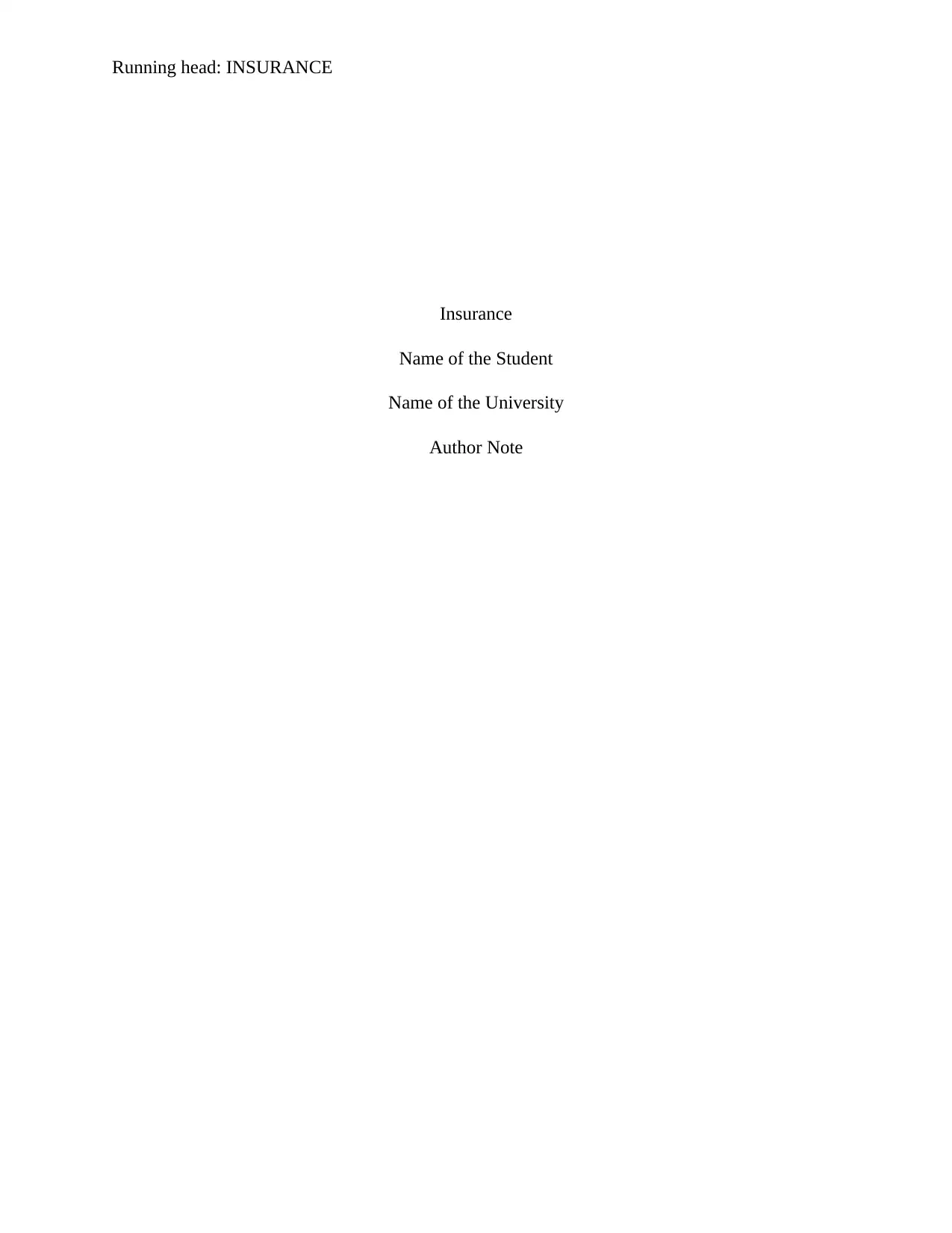
Running head: INSURANCE
Insurance
Name of the Student
Name of the University
Author Note
Insurance
Name of the Student
Name of the University
Author Note
Paraphrase This Document
Need a fresh take? Get an instant paraphrase of this document with our AI Paraphraser
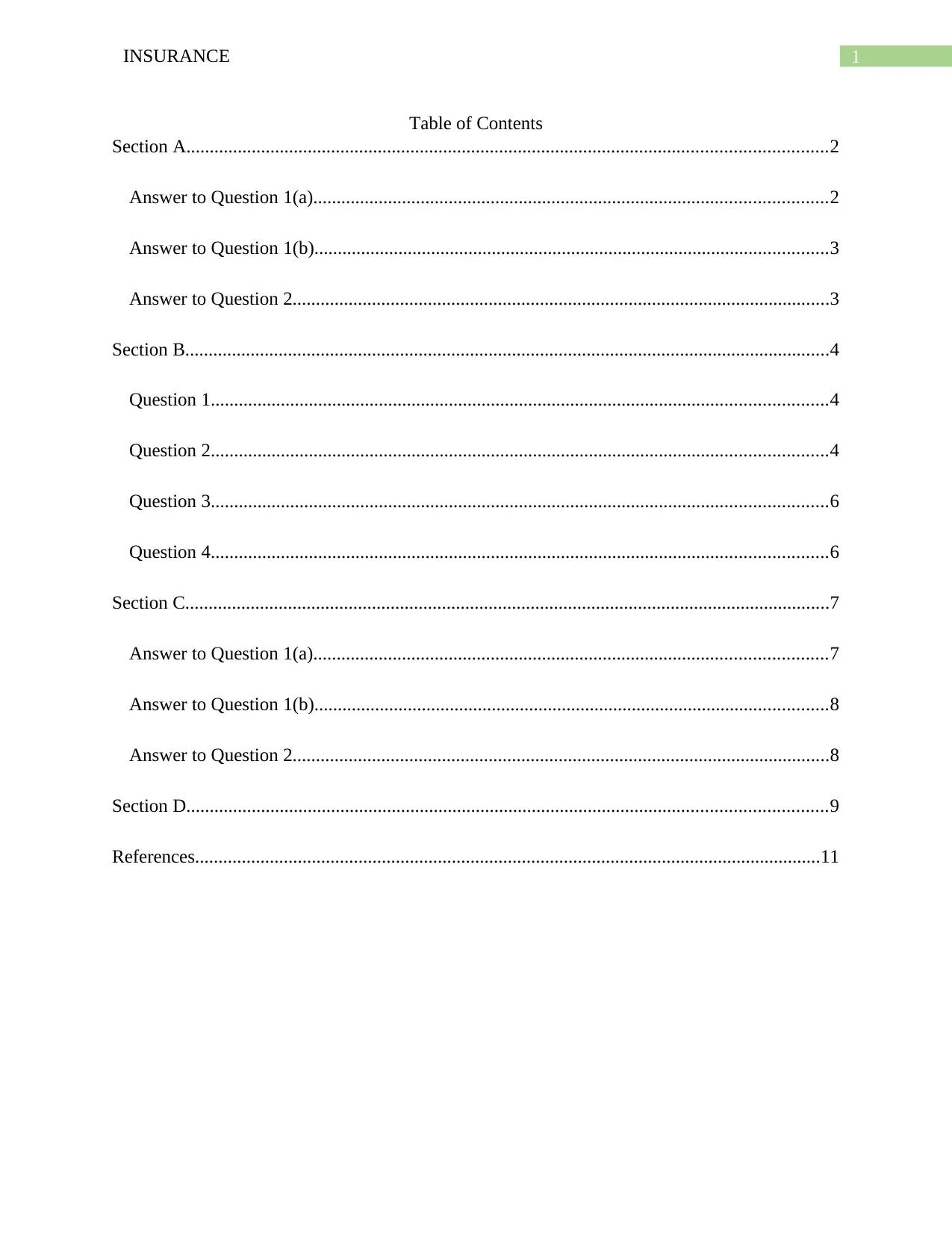
1INSURANCE
Table of Contents
Section A.........................................................................................................................................2
Answer to Question 1(a)..............................................................................................................2
Answer to Question 1(b)..............................................................................................................3
Answer to Question 2...................................................................................................................3
Section B..........................................................................................................................................4
Question 1....................................................................................................................................4
Question 2....................................................................................................................................4
Question 3....................................................................................................................................6
Question 4....................................................................................................................................6
Section C..........................................................................................................................................7
Answer to Question 1(a)..............................................................................................................7
Answer to Question 1(b)..............................................................................................................8
Answer to Question 2...................................................................................................................8
Section D.........................................................................................................................................9
References......................................................................................................................................11
Table of Contents
Section A.........................................................................................................................................2
Answer to Question 1(a)..............................................................................................................2
Answer to Question 1(b)..............................................................................................................3
Answer to Question 2...................................................................................................................3
Section B..........................................................................................................................................4
Question 1....................................................................................................................................4
Question 2....................................................................................................................................4
Question 3....................................................................................................................................6
Question 4....................................................................................................................................6
Section C..........................................................................................................................................7
Answer to Question 1(a)..............................................................................................................7
Answer to Question 1(b)..............................................................................................................8
Answer to Question 2...................................................................................................................8
Section D.........................................................................................................................................9
References......................................................................................................................................11
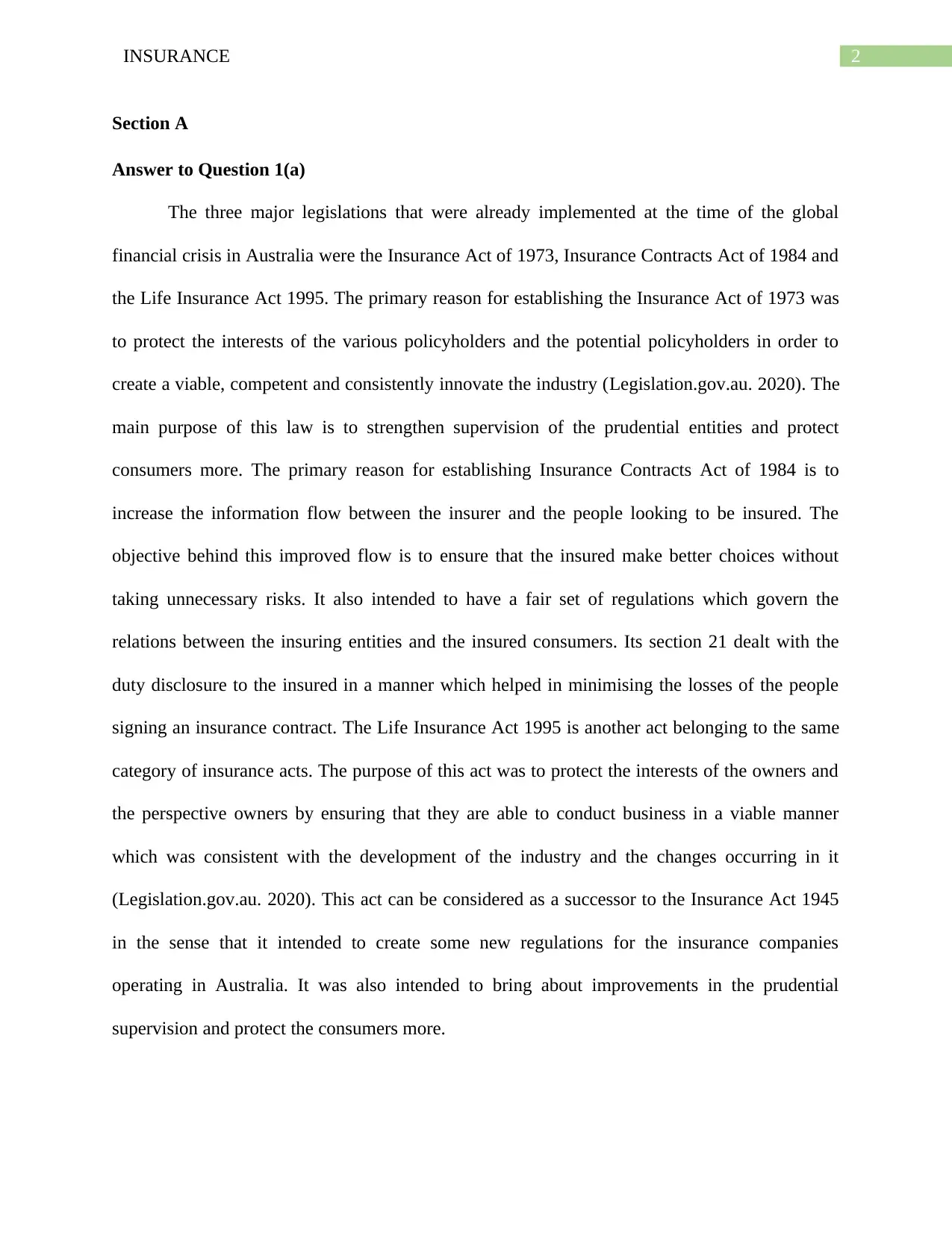
2INSURANCE
Section A
Answer to Question 1(a)
The three major legislations that were already implemented at the time of the global
financial crisis in Australia were the Insurance Act of 1973, Insurance Contracts Act of 1984 and
the Life Insurance Act 1995. The primary reason for establishing the Insurance Act of 1973 was
to protect the interests of the various policyholders and the potential policyholders in order to
create a viable, competent and consistently innovate the industry (Legislation.gov.au. 2020). The
main purpose of this law is to strengthen supervision of the prudential entities and protect
consumers more. The primary reason for establishing Insurance Contracts Act of 1984 is to
increase the information flow between the insurer and the people looking to be insured. The
objective behind this improved flow is to ensure that the insured make better choices without
taking unnecessary risks. It also intended to have a fair set of regulations which govern the
relations between the insuring entities and the insured consumers. Its section 21 dealt with the
duty disclosure to the insured in a manner which helped in minimising the losses of the people
signing an insurance contract. The Life Insurance Act 1995 is another act belonging to the same
category of insurance acts. The purpose of this act was to protect the interests of the owners and
the perspective owners by ensuring that they are able to conduct business in a viable manner
which was consistent with the development of the industry and the changes occurring in it
(Legislation.gov.au. 2020). This act can be considered as a successor to the Insurance Act 1945
in the sense that it intended to create some new regulations for the insurance companies
operating in Australia. It was also intended to bring about improvements in the prudential
supervision and protect the consumers more.
Section A
Answer to Question 1(a)
The three major legislations that were already implemented at the time of the global
financial crisis in Australia were the Insurance Act of 1973, Insurance Contracts Act of 1984 and
the Life Insurance Act 1995. The primary reason for establishing the Insurance Act of 1973 was
to protect the interests of the various policyholders and the potential policyholders in order to
create a viable, competent and consistently innovate the industry (Legislation.gov.au. 2020). The
main purpose of this law is to strengthen supervision of the prudential entities and protect
consumers more. The primary reason for establishing Insurance Contracts Act of 1984 is to
increase the information flow between the insurer and the people looking to be insured. The
objective behind this improved flow is to ensure that the insured make better choices without
taking unnecessary risks. It also intended to have a fair set of regulations which govern the
relations between the insuring entities and the insured consumers. Its section 21 dealt with the
duty disclosure to the insured in a manner which helped in minimising the losses of the people
signing an insurance contract. The Life Insurance Act 1995 is another act belonging to the same
category of insurance acts. The purpose of this act was to protect the interests of the owners and
the perspective owners by ensuring that they are able to conduct business in a viable manner
which was consistent with the development of the industry and the changes occurring in it
(Legislation.gov.au. 2020). This act can be considered as a successor to the Insurance Act 1945
in the sense that it intended to create some new regulations for the insurance companies
operating in Australia. It was also intended to bring about improvements in the prudential
supervision and protect the consumers more.
⊘ This is a preview!⊘
Do you want full access?
Subscribe today to unlock all pages.

Trusted by 1+ million students worldwide
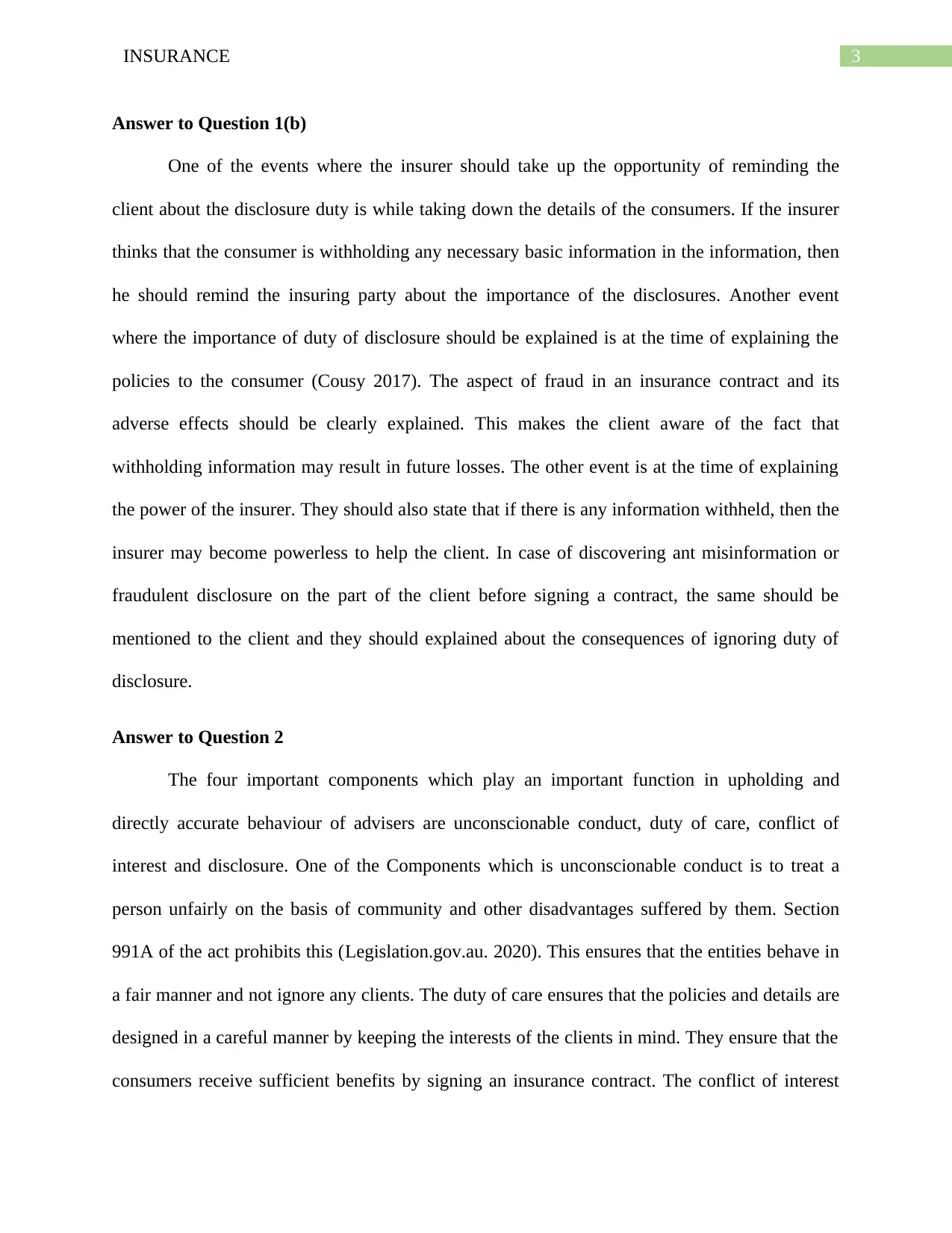
3INSURANCE
Answer to Question 1(b)
One of the events where the insurer should take up the opportunity of reminding the
client about the disclosure duty is while taking down the details of the consumers. If the insurer
thinks that the consumer is withholding any necessary basic information in the information, then
he should remind the insuring party about the importance of the disclosures. Another event
where the importance of duty of disclosure should be explained is at the time of explaining the
policies to the consumer (Cousy 2017). The aspect of fraud in an insurance contract and its
adverse effects should be clearly explained. This makes the client aware of the fact that
withholding information may result in future losses. The other event is at the time of explaining
the power of the insurer. They should also state that if there is any information withheld, then the
insurer may become powerless to help the client. In case of discovering ant misinformation or
fraudulent disclosure on the part of the client before signing a contract, the same should be
mentioned to the client and they should explained about the consequences of ignoring duty of
disclosure.
Answer to Question 2
The four important components which play an important function in upholding and
directly accurate behaviour of advisers are unconscionable conduct, duty of care, conflict of
interest and disclosure. One of the Components which is unconscionable conduct is to treat a
person unfairly on the basis of community and other disadvantages suffered by them. Section
991A of the act prohibits this (Legislation.gov.au. 2020). This ensures that the entities behave in
a fair manner and not ignore any clients. The duty of care ensures that the policies and details are
designed in a careful manner by keeping the interests of the clients in mind. They ensure that the
consumers receive sufficient benefits by signing an insurance contract. The conflict of interest
Answer to Question 1(b)
One of the events where the insurer should take up the opportunity of reminding the
client about the disclosure duty is while taking down the details of the consumers. If the insurer
thinks that the consumer is withholding any necessary basic information in the information, then
he should remind the insuring party about the importance of the disclosures. Another event
where the importance of duty of disclosure should be explained is at the time of explaining the
policies to the consumer (Cousy 2017). The aspect of fraud in an insurance contract and its
adverse effects should be clearly explained. This makes the client aware of the fact that
withholding information may result in future losses. The other event is at the time of explaining
the power of the insurer. They should also state that if there is any information withheld, then the
insurer may become powerless to help the client. In case of discovering ant misinformation or
fraudulent disclosure on the part of the client before signing a contract, the same should be
mentioned to the client and they should explained about the consequences of ignoring duty of
disclosure.
Answer to Question 2
The four important components which play an important function in upholding and
directly accurate behaviour of advisers are unconscionable conduct, duty of care, conflict of
interest and disclosure. One of the Components which is unconscionable conduct is to treat a
person unfairly on the basis of community and other disadvantages suffered by them. Section
991A of the act prohibits this (Legislation.gov.au. 2020). This ensures that the entities behave in
a fair manner and not ignore any clients. The duty of care ensures that the policies and details are
designed in a careful manner by keeping the interests of the clients in mind. They ensure that the
consumers receive sufficient benefits by signing an insurance contract. The conflict of interest
Paraphrase This Document
Need a fresh take? Get an instant paraphrase of this document with our AI Paraphraser
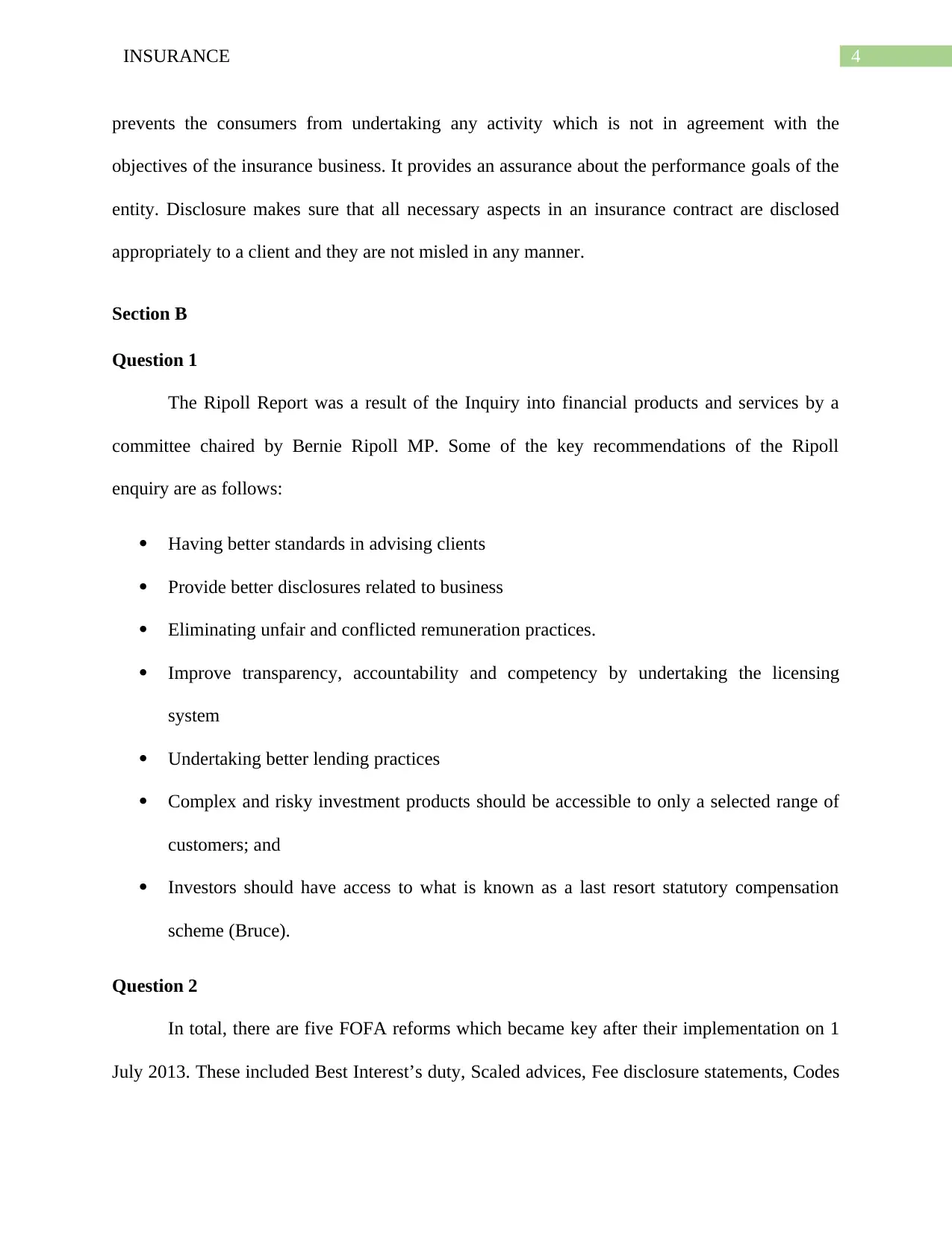
4INSURANCE
prevents the consumers from undertaking any activity which is not in agreement with the
objectives of the insurance business. It provides an assurance about the performance goals of the
entity. Disclosure makes sure that all necessary aspects in an insurance contract are disclosed
appropriately to a client and they are not misled in any manner.
Section B
Question 1
The Ripoll Report was a result of the Inquiry into financial products and services by a
committee chaired by Bernie Ripoll MP. Some of the key recommendations of the Ripoll
enquiry are as follows:
Having better standards in advising clients
Provide better disclosures related to business
Eliminating unfair and conflicted remuneration practices.
Improve transparency, accountability and competency by undertaking the licensing
system
Undertaking better lending practices
Complex and risky investment products should be accessible to only a selected range of
customers; and
Investors should have access to what is known as a last resort statutory compensation
scheme (Bruce).
Question 2
In total, there are five FOFA reforms which became key after their implementation on 1
July 2013. These included Best Interest’s duty, Scaled advices, Fee disclosure statements, Codes
prevents the consumers from undertaking any activity which is not in agreement with the
objectives of the insurance business. It provides an assurance about the performance goals of the
entity. Disclosure makes sure that all necessary aspects in an insurance contract are disclosed
appropriately to a client and they are not misled in any manner.
Section B
Question 1
The Ripoll Report was a result of the Inquiry into financial products and services by a
committee chaired by Bernie Ripoll MP. Some of the key recommendations of the Ripoll
enquiry are as follows:
Having better standards in advising clients
Provide better disclosures related to business
Eliminating unfair and conflicted remuneration practices.
Improve transparency, accountability and competency by undertaking the licensing
system
Undertaking better lending practices
Complex and risky investment products should be accessible to only a selected range of
customers; and
Investors should have access to what is known as a last resort statutory compensation
scheme (Bruce).
Question 2
In total, there are five FOFA reforms which became key after their implementation on 1
July 2013. These included Best Interest’s duty, Scaled advices, Fee disclosure statements, Codes
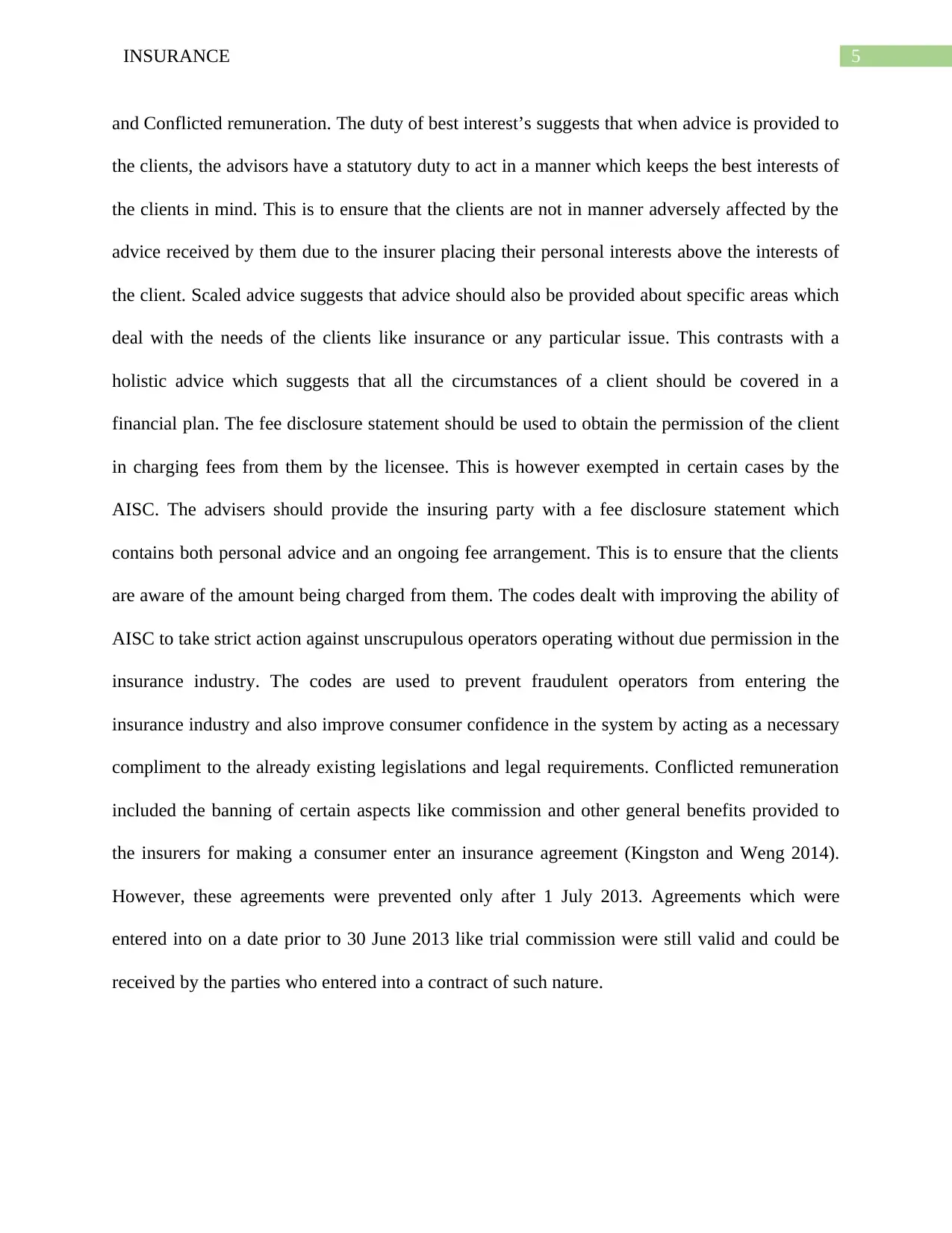
5INSURANCE
and Conflicted remuneration. The duty of best interest’s suggests that when advice is provided to
the clients, the advisors have a statutory duty to act in a manner which keeps the best interests of
the clients in mind. This is to ensure that the clients are not in manner adversely affected by the
advice received by them due to the insurer placing their personal interests above the interests of
the client. Scaled advice suggests that advice should also be provided about specific areas which
deal with the needs of the clients like insurance or any particular issue. This contrasts with a
holistic advice which suggests that all the circumstances of a client should be covered in a
financial plan. The fee disclosure statement should be used to obtain the permission of the client
in charging fees from them by the licensee. This is however exempted in certain cases by the
AISC. The advisers should provide the insuring party with a fee disclosure statement which
contains both personal advice and an ongoing fee arrangement. This is to ensure that the clients
are aware of the amount being charged from them. The codes dealt with improving the ability of
AISC to take strict action against unscrupulous operators operating without due permission in the
insurance industry. The codes are used to prevent fraudulent operators from entering the
insurance industry and also improve consumer confidence in the system by acting as a necessary
compliment to the already existing legislations and legal requirements. Conflicted remuneration
included the banning of certain aspects like commission and other general benefits provided to
the insurers for making a consumer enter an insurance agreement (Kingston and Weng 2014).
However, these agreements were prevented only after 1 July 2013. Agreements which were
entered into on a date prior to 30 June 2013 like trial commission were still valid and could be
received by the parties who entered into a contract of such nature.
and Conflicted remuneration. The duty of best interest’s suggests that when advice is provided to
the clients, the advisors have a statutory duty to act in a manner which keeps the best interests of
the clients in mind. This is to ensure that the clients are not in manner adversely affected by the
advice received by them due to the insurer placing their personal interests above the interests of
the client. Scaled advice suggests that advice should also be provided about specific areas which
deal with the needs of the clients like insurance or any particular issue. This contrasts with a
holistic advice which suggests that all the circumstances of a client should be covered in a
financial plan. The fee disclosure statement should be used to obtain the permission of the client
in charging fees from them by the licensee. This is however exempted in certain cases by the
AISC. The advisers should provide the insuring party with a fee disclosure statement which
contains both personal advice and an ongoing fee arrangement. This is to ensure that the clients
are aware of the amount being charged from them. The codes dealt with improving the ability of
AISC to take strict action against unscrupulous operators operating without due permission in the
insurance industry. The codes are used to prevent fraudulent operators from entering the
insurance industry and also improve consumer confidence in the system by acting as a necessary
compliment to the already existing legislations and legal requirements. Conflicted remuneration
included the banning of certain aspects like commission and other general benefits provided to
the insurers for making a consumer enter an insurance agreement (Kingston and Weng 2014).
However, these agreements were prevented only after 1 July 2013. Agreements which were
entered into on a date prior to 30 June 2013 like trial commission were still valid and could be
received by the parties who entered into a contract of such nature.
⊘ This is a preview!⊘
Do you want full access?
Subscribe today to unlock all pages.

Trusted by 1+ million students worldwide
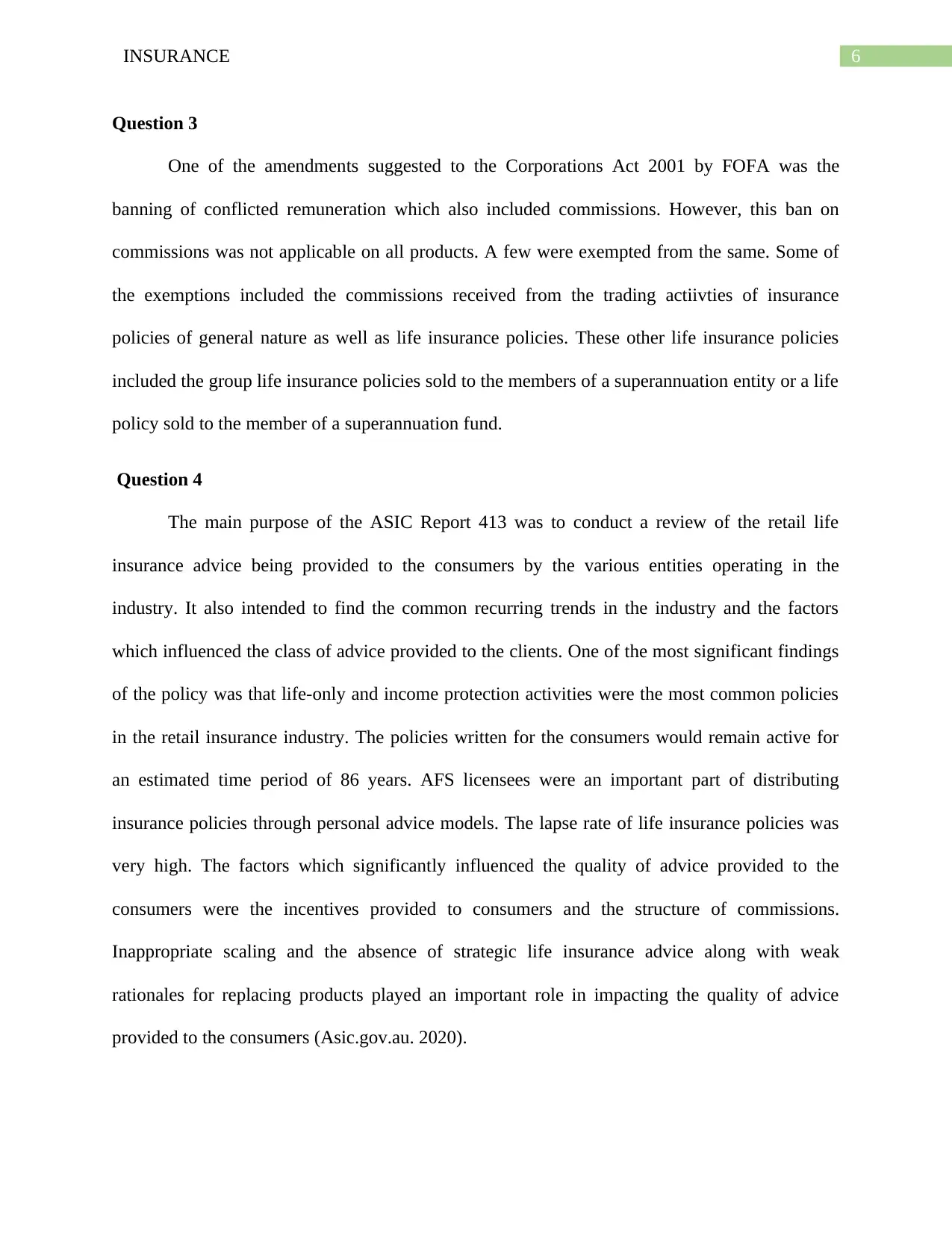
6INSURANCE
Question 3
One of the amendments suggested to the Corporations Act 2001 by FOFA was the
banning of conflicted remuneration which also included commissions. However, this ban on
commissions was not applicable on all products. A few were exempted from the same. Some of
the exemptions included the commissions received from the trading actiivties of insurance
policies of general nature as well as life insurance policies. These other life insurance policies
included the group life insurance policies sold to the members of a superannuation entity or a life
policy sold to the member of a superannuation fund.
Question 4
The main purpose of the ASIC Report 413 was to conduct a review of the retail life
insurance advice being provided to the consumers by the various entities operating in the
industry. It also intended to find the common recurring trends in the industry and the factors
which influenced the class of advice provided to the clients. One of the most significant findings
of the policy was that life-only and income protection activities were the most common policies
in the retail insurance industry. The policies written for the consumers would remain active for
an estimated time period of 86 years. AFS licensees were an important part of distributing
insurance policies through personal advice models. The lapse rate of life insurance policies was
very high. The factors which significantly influenced the quality of advice provided to the
consumers were the incentives provided to consumers and the structure of commissions.
Inappropriate scaling and the absence of strategic life insurance advice along with weak
rationales for replacing products played an important role in impacting the quality of advice
provided to the consumers (Asic.gov.au. 2020).
Question 3
One of the amendments suggested to the Corporations Act 2001 by FOFA was the
banning of conflicted remuneration which also included commissions. However, this ban on
commissions was not applicable on all products. A few were exempted from the same. Some of
the exemptions included the commissions received from the trading actiivties of insurance
policies of general nature as well as life insurance policies. These other life insurance policies
included the group life insurance policies sold to the members of a superannuation entity or a life
policy sold to the member of a superannuation fund.
Question 4
The main purpose of the ASIC Report 413 was to conduct a review of the retail life
insurance advice being provided to the consumers by the various entities operating in the
industry. It also intended to find the common recurring trends in the industry and the factors
which influenced the class of advice provided to the clients. One of the most significant findings
of the policy was that life-only and income protection activities were the most common policies
in the retail insurance industry. The policies written for the consumers would remain active for
an estimated time period of 86 years. AFS licensees were an important part of distributing
insurance policies through personal advice models. The lapse rate of life insurance policies was
very high. The factors which significantly influenced the quality of advice provided to the
consumers were the incentives provided to consumers and the structure of commissions.
Inappropriate scaling and the absence of strategic life insurance advice along with weak
rationales for replacing products played an important role in impacting the quality of advice
provided to the consumers (Asic.gov.au. 2020).
Paraphrase This Document
Need a fresh take? Get an instant paraphrase of this document with our AI Paraphraser
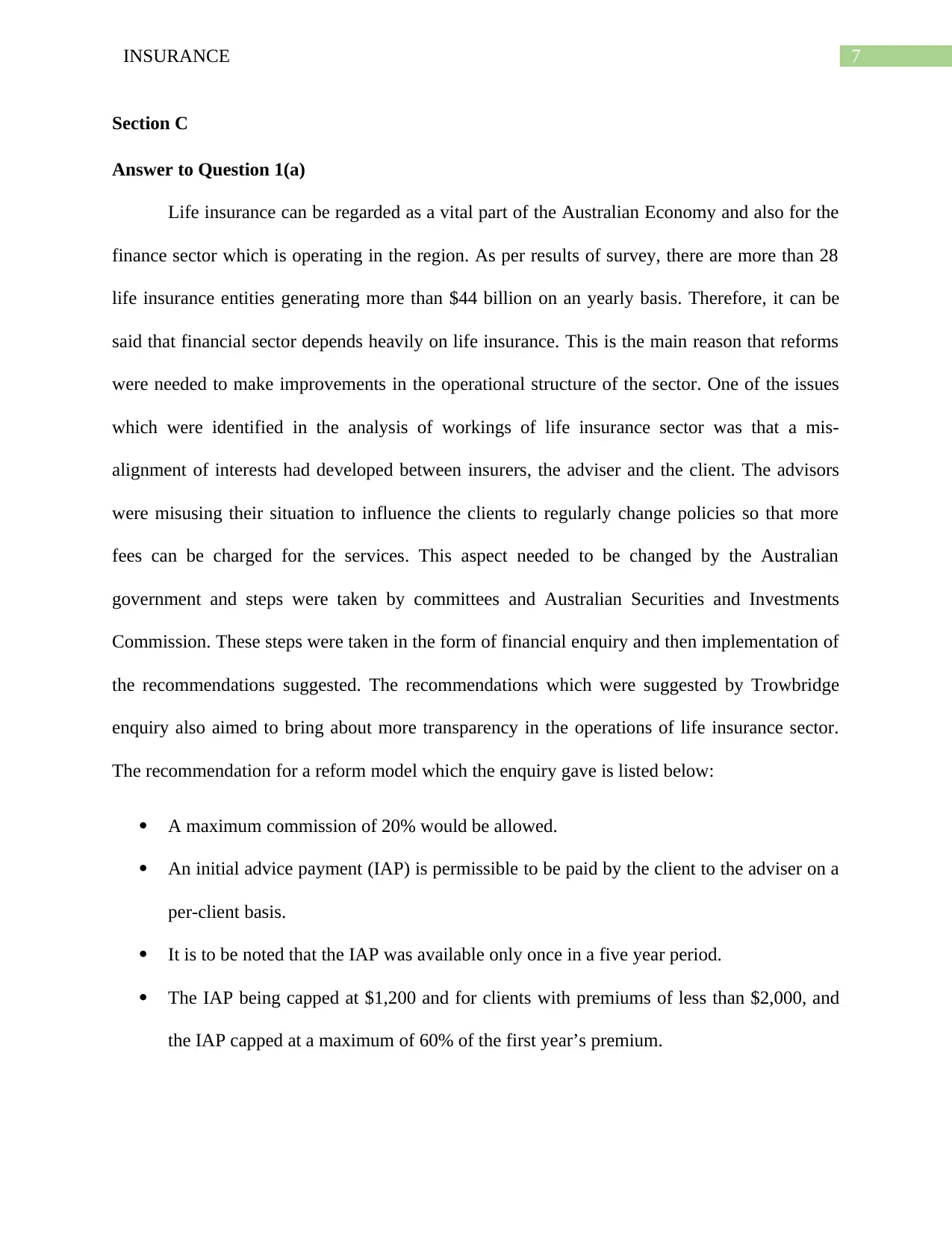
7INSURANCE
Section C
Answer to Question 1(a)
Life insurance can be regarded as a vital part of the Australian Economy and also for the
finance sector which is operating in the region. As per results of survey, there are more than 28
life insurance entities generating more than $44 billion on an yearly basis. Therefore, it can be
said that financial sector depends heavily on life insurance. This is the main reason that reforms
were needed to make improvements in the operational structure of the sector. One of the issues
which were identified in the analysis of workings of life insurance sector was that a mis-
alignment of interests had developed between insurers, the adviser and the client. The advisors
were misusing their situation to influence the clients to regularly change policies so that more
fees can be charged for the services. This aspect needed to be changed by the Australian
government and steps were taken by committees and Australian Securities and Investments
Commission. These steps were taken in the form of financial enquiry and then implementation of
the recommendations suggested. The recommendations which were suggested by Trowbridge
enquiry also aimed to bring about more transparency in the operations of life insurance sector.
The recommendation for a reform model which the enquiry gave is listed below:
A maximum commission of 20% would be allowed.
An initial advice payment (IAP) is permissible to be paid by the client to the adviser on a
per-client basis.
It is to be noted that the IAP was available only once in a five year period.
The IAP being capped at $1,200 and for clients with premiums of less than $2,000, and
the IAP capped at a maximum of 60% of the first year’s premium.
Section C
Answer to Question 1(a)
Life insurance can be regarded as a vital part of the Australian Economy and also for the
finance sector which is operating in the region. As per results of survey, there are more than 28
life insurance entities generating more than $44 billion on an yearly basis. Therefore, it can be
said that financial sector depends heavily on life insurance. This is the main reason that reforms
were needed to make improvements in the operational structure of the sector. One of the issues
which were identified in the analysis of workings of life insurance sector was that a mis-
alignment of interests had developed between insurers, the adviser and the client. The advisors
were misusing their situation to influence the clients to regularly change policies so that more
fees can be charged for the services. This aspect needed to be changed by the Australian
government and steps were taken by committees and Australian Securities and Investments
Commission. These steps were taken in the form of financial enquiry and then implementation of
the recommendations suggested. The recommendations which were suggested by Trowbridge
enquiry also aimed to bring about more transparency in the operations of life insurance sector.
The recommendation for a reform model which the enquiry gave is listed below:
A maximum commission of 20% would be allowed.
An initial advice payment (IAP) is permissible to be paid by the client to the adviser on a
per-client basis.
It is to be noted that the IAP was available only once in a five year period.
The IAP being capped at $1,200 and for clients with premiums of less than $2,000, and
the IAP capped at a maximum of 60% of the first year’s premium.
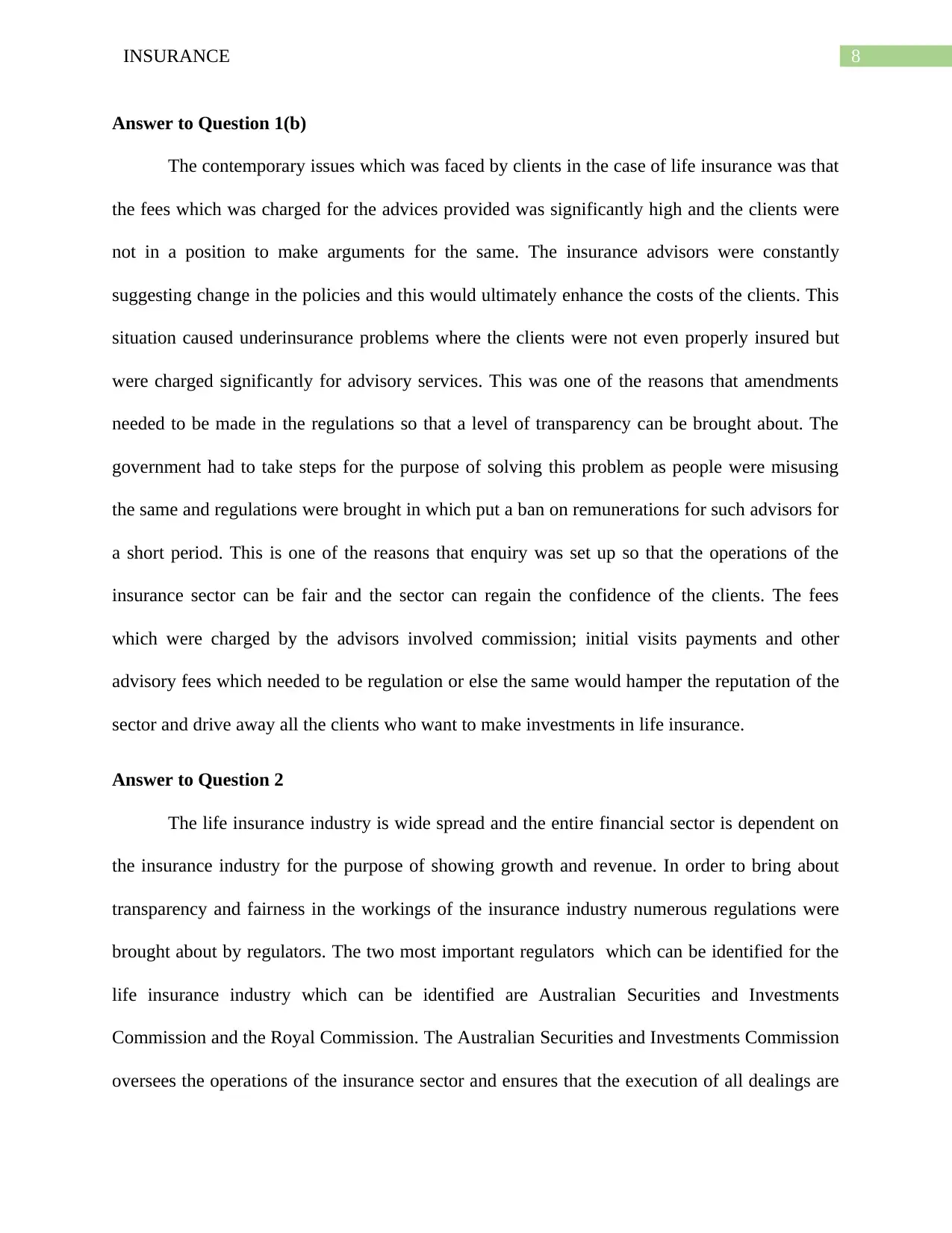
8INSURANCE
Answer to Question 1(b)
The contemporary issues which was faced by clients in the case of life insurance was that
the fees which was charged for the advices provided was significantly high and the clients were
not in a position to make arguments for the same. The insurance advisors were constantly
suggesting change in the policies and this would ultimately enhance the costs of the clients. This
situation caused underinsurance problems where the clients were not even properly insured but
were charged significantly for advisory services. This was one of the reasons that amendments
needed to be made in the regulations so that a level of transparency can be brought about. The
government had to take steps for the purpose of solving this problem as people were misusing
the same and regulations were brought in which put a ban on remunerations for such advisors for
a short period. This is one of the reasons that enquiry was set up so that the operations of the
insurance sector can be fair and the sector can regain the confidence of the clients. The fees
which were charged by the advisors involved commission; initial visits payments and other
advisory fees which needed to be regulation or else the same would hamper the reputation of the
sector and drive away all the clients who want to make investments in life insurance.
Answer to Question 2
The life insurance industry is wide spread and the entire financial sector is dependent on
the insurance industry for the purpose of showing growth and revenue. In order to bring about
transparency and fairness in the workings of the insurance industry numerous regulations were
brought about by regulators. The two most important regulators which can be identified for the
life insurance industry which can be identified are Australian Securities and Investments
Commission and the Royal Commission. The Australian Securities and Investments Commission
oversees the operations of the insurance sector and ensures that the execution of all dealings are
Answer to Question 1(b)
The contemporary issues which was faced by clients in the case of life insurance was that
the fees which was charged for the advices provided was significantly high and the clients were
not in a position to make arguments for the same. The insurance advisors were constantly
suggesting change in the policies and this would ultimately enhance the costs of the clients. This
situation caused underinsurance problems where the clients were not even properly insured but
were charged significantly for advisory services. This was one of the reasons that amendments
needed to be made in the regulations so that a level of transparency can be brought about. The
government had to take steps for the purpose of solving this problem as people were misusing
the same and regulations were brought in which put a ban on remunerations for such advisors for
a short period. This is one of the reasons that enquiry was set up so that the operations of the
insurance sector can be fair and the sector can regain the confidence of the clients. The fees
which were charged by the advisors involved commission; initial visits payments and other
advisory fees which needed to be regulation or else the same would hamper the reputation of the
sector and drive away all the clients who want to make investments in life insurance.
Answer to Question 2
The life insurance industry is wide spread and the entire financial sector is dependent on
the insurance industry for the purpose of showing growth and revenue. In order to bring about
transparency and fairness in the workings of the insurance industry numerous regulations were
brought about by regulators. The two most important regulators which can be identified for the
life insurance industry which can be identified are Australian Securities and Investments
Commission and the Royal Commission. The Australian Securities and Investments Commission
oversees the operations of the insurance sector and ensures that the execution of all dealings are
⊘ This is a preview!⊘
Do you want full access?
Subscribe today to unlock all pages.

Trusted by 1+ million students worldwide
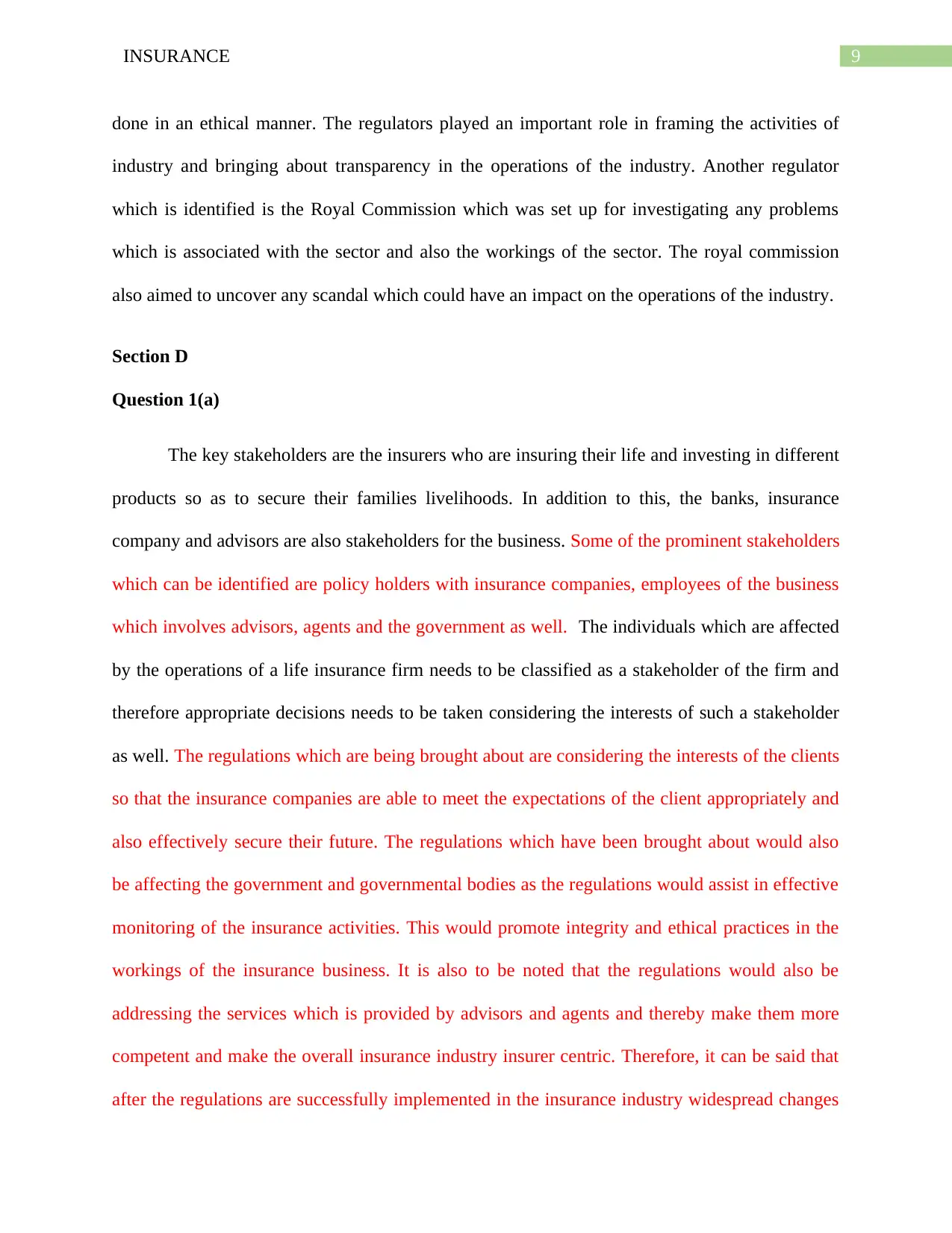
9INSURANCE
done in an ethical manner. The regulators played an important role in framing the activities of
industry and bringing about transparency in the operations of the industry. Another regulator
which is identified is the Royal Commission which was set up for investigating any problems
which is associated with the sector and also the workings of the sector. The royal commission
also aimed to uncover any scandal which could have an impact on the operations of the industry.
Section D
Question 1(a)
The key stakeholders are the insurers who are insuring their life and investing in different
products so as to secure their families livelihoods. In addition to this, the banks, insurance
company and advisors are also stakeholders for the business. Some of the prominent stakeholders
which can be identified are policy holders with insurance companies, employees of the business
which involves advisors, agents and the government as well. The individuals which are affected
by the operations of a life insurance firm needs to be classified as a stakeholder of the firm and
therefore appropriate decisions needs to be taken considering the interests of such a stakeholder
as well. The regulations which are being brought about are considering the interests of the clients
so that the insurance companies are able to meet the expectations of the client appropriately and
also effectively secure their future. The regulations which have been brought about would also
be affecting the government and governmental bodies as the regulations would assist in effective
monitoring of the insurance activities. This would promote integrity and ethical practices in the
workings of the insurance business. It is also to be noted that the regulations would also be
addressing the services which is provided by advisors and agents and thereby make them more
competent and make the overall insurance industry insurer centric. Therefore, it can be said that
after the regulations are successfully implemented in the insurance industry widespread changes
done in an ethical manner. The regulators played an important role in framing the activities of
industry and bringing about transparency in the operations of the industry. Another regulator
which is identified is the Royal Commission which was set up for investigating any problems
which is associated with the sector and also the workings of the sector. The royal commission
also aimed to uncover any scandal which could have an impact on the operations of the industry.
Section D
Question 1(a)
The key stakeholders are the insurers who are insuring their life and investing in different
products so as to secure their families livelihoods. In addition to this, the banks, insurance
company and advisors are also stakeholders for the business. Some of the prominent stakeholders
which can be identified are policy holders with insurance companies, employees of the business
which involves advisors, agents and the government as well. The individuals which are affected
by the operations of a life insurance firm needs to be classified as a stakeholder of the firm and
therefore appropriate decisions needs to be taken considering the interests of such a stakeholder
as well. The regulations which are being brought about are considering the interests of the clients
so that the insurance companies are able to meet the expectations of the client appropriately and
also effectively secure their future. The regulations which have been brought about would also
be affecting the government and governmental bodies as the regulations would assist in effective
monitoring of the insurance activities. This would promote integrity and ethical practices in the
workings of the insurance business. It is also to be noted that the regulations would also be
addressing the services which is provided by advisors and agents and thereby make them more
competent and make the overall insurance industry insurer centric. Therefore, it can be said that
after the regulations are successfully implemented in the insurance industry widespread changes
Paraphrase This Document
Need a fresh take? Get an instant paraphrase of this document with our AI Paraphraser
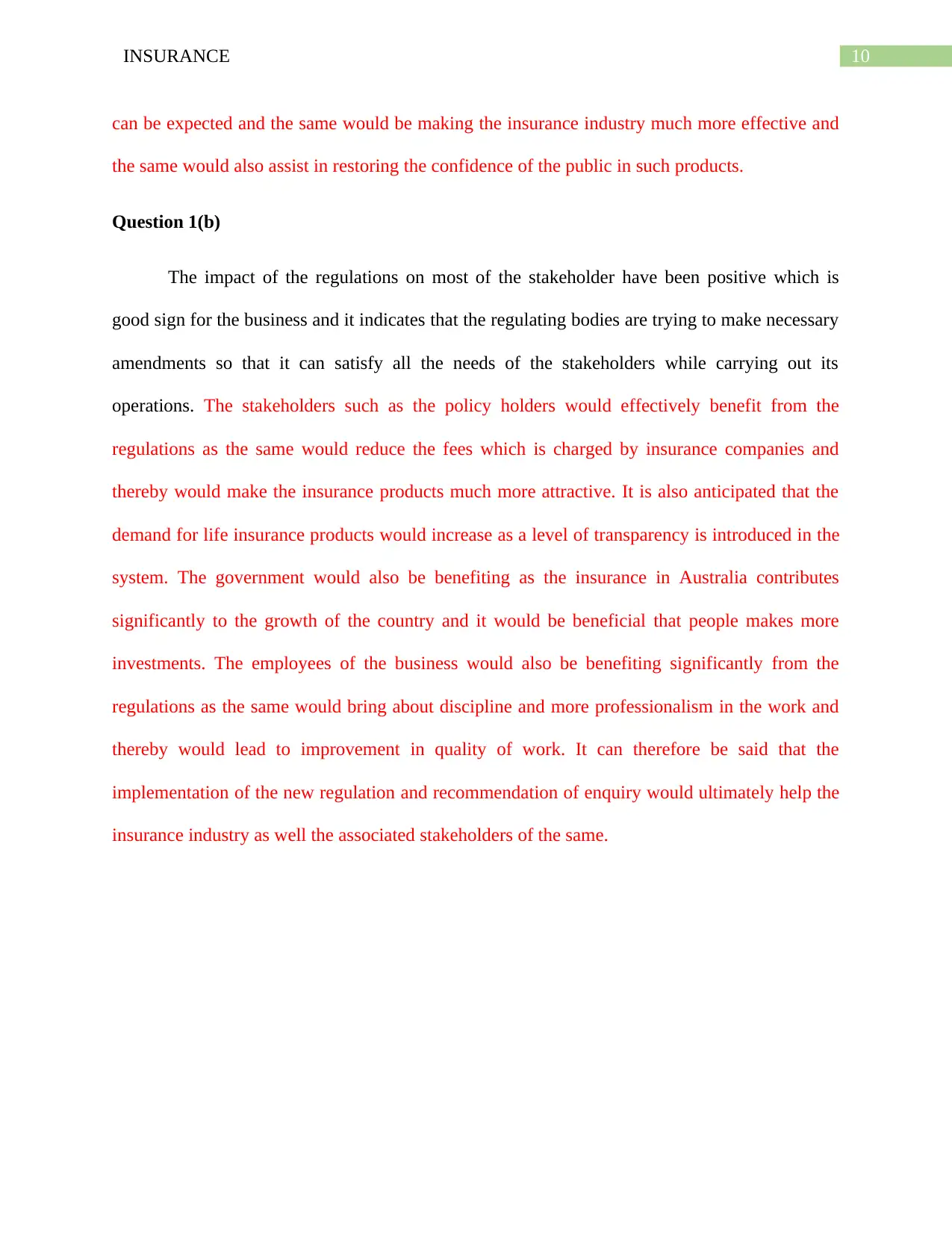
10INSURANCE
can be expected and the same would be making the insurance industry much more effective and
the same would also assist in restoring the confidence of the public in such products.
Question 1(b)
The impact of the regulations on most of the stakeholder have been positive which is
good sign for the business and it indicates that the regulating bodies are trying to make necessary
amendments so that it can satisfy all the needs of the stakeholders while carrying out its
operations. The stakeholders such as the policy holders would effectively benefit from the
regulations as the same would reduce the fees which is charged by insurance companies and
thereby would make the insurance products much more attractive. It is also anticipated that the
demand for life insurance products would increase as a level of transparency is introduced in the
system. The government would also be benefiting as the insurance in Australia contributes
significantly to the growth of the country and it would be beneficial that people makes more
investments. The employees of the business would also be benefiting significantly from the
regulations as the same would bring about discipline and more professionalism in the work and
thereby would lead to improvement in quality of work. It can therefore be said that the
implementation of the new regulation and recommendation of enquiry would ultimately help the
insurance industry as well the associated stakeholders of the same.
can be expected and the same would be making the insurance industry much more effective and
the same would also assist in restoring the confidence of the public in such products.
Question 1(b)
The impact of the regulations on most of the stakeholder have been positive which is
good sign for the business and it indicates that the regulating bodies are trying to make necessary
amendments so that it can satisfy all the needs of the stakeholders while carrying out its
operations. The stakeholders such as the policy holders would effectively benefit from the
regulations as the same would reduce the fees which is charged by insurance companies and
thereby would make the insurance products much more attractive. It is also anticipated that the
demand for life insurance products would increase as a level of transparency is introduced in the
system. The government would also be benefiting as the insurance in Australia contributes
significantly to the growth of the country and it would be beneficial that people makes more
investments. The employees of the business would also be benefiting significantly from the
regulations as the same would bring about discipline and more professionalism in the work and
thereby would lead to improvement in quality of work. It can therefore be said that the
implementation of the new regulation and recommendation of enquiry would ultimately help the
insurance industry as well the associated stakeholders of the same.
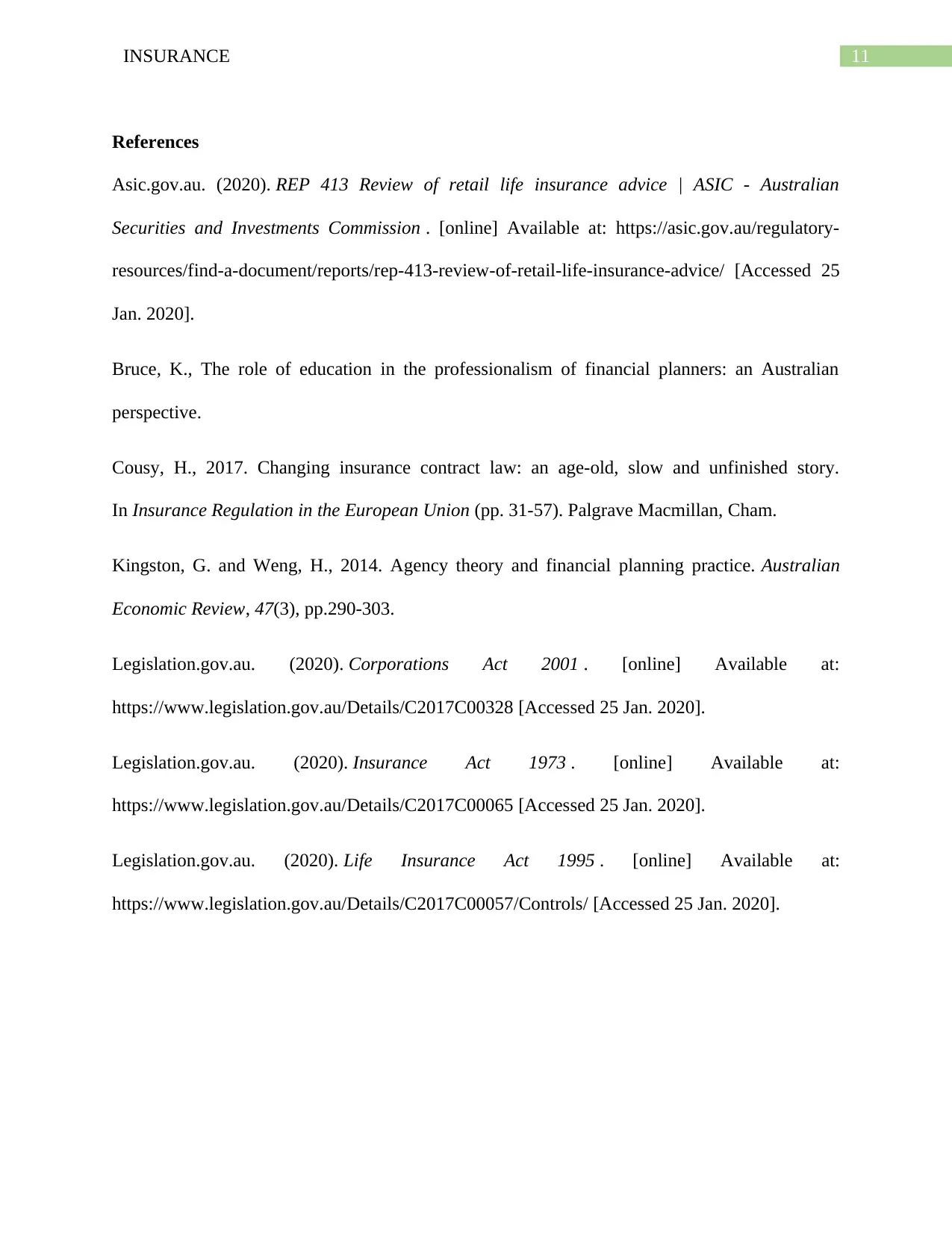
11INSURANCE
References
Asic.gov.au. (2020). REP 413 Review of retail life insurance advice | ASIC - Australian
Securities and Investments Commission . [online] Available at: https://asic.gov.au/regulatory-
resources/find-a-document/reports/rep-413-review-of-retail-life-insurance-advice/ [Accessed 25
Jan. 2020].
Bruce, K., The role of education in the professionalism of financial planners: an Australian
perspective.
Cousy, H., 2017. Changing insurance contract law: an age-old, slow and unfinished story.
In Insurance Regulation in the European Union (pp. 31-57). Palgrave Macmillan, Cham.
Kingston, G. and Weng, H., 2014. Agency theory and financial planning practice. Australian
Economic Review, 47(3), pp.290-303.
Legislation.gov.au. (2020). Corporations Act 2001 . [online] Available at:
https://www.legislation.gov.au/Details/C2017C00328 [Accessed 25 Jan. 2020].
Legislation.gov.au. (2020). Insurance Act 1973 . [online] Available at:
https://www.legislation.gov.au/Details/C2017C00065 [Accessed 25 Jan. 2020].
Legislation.gov.au. (2020). Life Insurance Act 1995 . [online] Available at:
https://www.legislation.gov.au/Details/C2017C00057/Controls/ [Accessed 25 Jan. 2020].
References
Asic.gov.au. (2020). REP 413 Review of retail life insurance advice | ASIC - Australian
Securities and Investments Commission . [online] Available at: https://asic.gov.au/regulatory-
resources/find-a-document/reports/rep-413-review-of-retail-life-insurance-advice/ [Accessed 25
Jan. 2020].
Bruce, K., The role of education in the professionalism of financial planners: an Australian
perspective.
Cousy, H., 2017. Changing insurance contract law: an age-old, slow and unfinished story.
In Insurance Regulation in the European Union (pp. 31-57). Palgrave Macmillan, Cham.
Kingston, G. and Weng, H., 2014. Agency theory and financial planning practice. Australian
Economic Review, 47(3), pp.290-303.
Legislation.gov.au. (2020). Corporations Act 2001 . [online] Available at:
https://www.legislation.gov.au/Details/C2017C00328 [Accessed 25 Jan. 2020].
Legislation.gov.au. (2020). Insurance Act 1973 . [online] Available at:
https://www.legislation.gov.au/Details/C2017C00065 [Accessed 25 Jan. 2020].
Legislation.gov.au. (2020). Life Insurance Act 1995 . [online] Available at:
https://www.legislation.gov.au/Details/C2017C00057/Controls/ [Accessed 25 Jan. 2020].
⊘ This is a preview!⊘
Do you want full access?
Subscribe today to unlock all pages.

Trusted by 1+ million students worldwide
1 out of 13
Your All-in-One AI-Powered Toolkit for Academic Success.
+13062052269
info@desklib.com
Available 24*7 on WhatsApp / Email
![[object Object]](/_next/static/media/star-bottom.7253800d.svg)
Unlock your academic potential
Copyright © 2020–2025 A2Z Services. All Rights Reserved. Developed and managed by ZUCOL.
